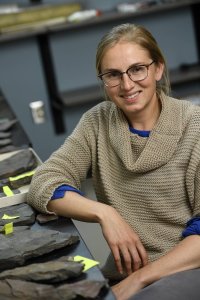Presented By: Earth and Environmental Sciences
Smith Lecture: Emmy Smith
Stratigraphic constraints on early animal evolution

Since Darwin first noted the seemingly abrupt appearance of fossils in Cambrian strata, the cause and tempo of the ‘Cambrian Explosion’ has remained one of Earth Science’s most provocative research topics. Contrary to Darwin’s hypothesis that this phenomenon reflected a largely eroded and imperfect geological record, scientists have spent the past 70 years unraveling a diverse Precambrian biosphere characterized by the deep roots of eukaryotic evolution. Now, it is generally agreed that the Neoproterozoic origins of animals and multicellularity are at least partly related to genetic challenges (e.g., Butterfield, 2018); however, the simultaneous explosion in body size, morphological features, and skeletonization in the Cambrian is almost certainly the result of external “triggers” (e.g., Erwin et al., 2011; Zhang et al., 2014; Schiffbauer et al., 2016), the nature of which have been widely debated. Mechanistic hypotheses for the Cambrian radiation have ranged from ecological concepts, such as ecosystem engineering (Butterfield, 2011; Erwin and Tweedt, 2012; Butterfield, 2018), changes in resource patchiness (Budd and Jensen, 2017), or organism-organism interactions (Peterson et al., 2005; Marshall, 2006; Schiffbauer et al., 2016), to environmental parameters like marine oxygenation (e.g., Sperling et al., 2013), changes in global seawater chemistry (Peters and Gaines, 2012), an increase in nutrient or food resources (Cook and Shergold, 1984; Sperling and Stockey, 2018), or true polar wander (Mitchell et al., 2015). Despite the diversity of these hypotheses, the question of timing has consistently surfaced as a critical component in evaluating the proposed drivers of the Cambrian radiation.